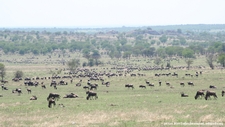Communities and Populations
Supporting

TEKS Objective
The student is expected to observe and describe the physical characteristics of environments and how they support populations and communities within an ecosystem.
Essential Understanding
The student knows that organisms have characteristics that help them survive and can describe patterns, cycles, systems, and relationships within the environments.
Science Background
What Are Ecosystems?: PBS (website) - Ecosystems are communities of interacting organisms and the physical environments in which they live. Learn more about the general characteristics that define an ecosystem, and about specific elements found in different kinds of ecosystems (coastal, forest, etc.).
What Are Ecosystems?
PBS, http://www.pbs.org/
An Ecological System: Geography4Kids (website) - Information about ecosystems, biomes and ecotones, with links to additional, related content and resources.
An Ecological System
Geography4Kid, http://www.geography4kids.com/
Neighborhoods: The Franklin Institute (website) - Descriptions and background information for ecosystems, habitats and biomes, along with links to many additional related resources and activities.
Signature Lesson
TerrAqua Column: What is the Land-Water Connection? Bottle Biology (website) - Using a simple soft drink bottle, students create an ecosystem with three basic components (soil, water, plants) that enables them to explore the links between land and water; observe and describe physical characteristics of environments within the ecosystem; and investigate how they support living organisms.
TerrAqua Column
Bottle Biology, http://www.bottlebiology.org/
- Supporting Lessons
- Extensions
- Assessment Ideas
- Literature Connections
- Related
TEKS - Additional Resources
Supporting Lessons
Habitat Breakdown: Texas A&M University (website) - Investigate the critical roles that food, water, shelter and space play in enabling organisms to survive in a given habitat. Includes assessment and math connections.
Habitat Breakdown
Texas A&M University, http://iitc.tamu.edu/
Elementary Ecosystems: Nation Geographic (website) - Explore the basics of species interdependency within an ecosystem and learn the importance of biodiversity by performing a simple simulation to discover how one species within an ecosystem can affect many others.
Elementary Ecosystems
Nation Geographic, http://www.nationalgeographic.com/xpeditions/
Elaboration Lessons and Extensions
Habitats of the World: Discovery Education (website) – Students work in teams to collect information about different habitats of the world.
Habitats of the World
Discovery Education, http://www.discoveryeducation.com/
Ecosystems: Texas A&M University (website) - Take a field trip to a pond or stream. Collect a water sample and place it in a large pickle jar, making sure to include water from the bottom of the pond or stream. Observe the living and non-living things in the jar. Includes assessment and math connections.
Assessment Ideas
Over a period of three to four weeks, have students make daily observations of the TerrAqua ecosystems created in the Signature Lesson, and record any developments in their science notebooks. At the end of the observation period, ask the following questions.
- What physical characteristics of the environment support the organisms living in the TerrAqua column?
- How do the living organisms within this ecosystem rely on each other for survival?
- How do the organisms within this ecosystem rely on the non-living objects for survival?
Literature Connections
Exploring Ecosystems with Max Axiom, Super Scientist. Biskup, Agnieszka (ISBN-13: 978-0736878944)
Changing Ecosystems. Bright, Michael (ISBN-13: 978-1432916589)
The Ecosystem of a Stream. Pascoe, Elaine (ISBN-13: 978-1435836884)
Populations and Ecosystems. Glass, Susan (ISBN-13: 978-0756944810)
Earth’s Growing Population. Chambers, Catherine (ISBN-13: 978-1432924232)
Additional Resources
Ecosystems: NeoK12 (website) - Photos, videos, presentations, games and quizzes that can be used to teach the concept of ecosystems.
Ecosystems
NeoK12, http://www.neok12.com/
Habitat Breakdown: Texas A&M University (website) - Investigate the critical roles that food, water, shelter and space play in enabling organisms to survive in a given habitat. Includes assessment and math connections.
Habitat Breakdown
Texas A&M University, http://iitc.tamu.edu/
TEKS Navigation
Grade 3
Need Assistance?
If you need help or have a question please use the links below to help resolve your problem.

Comments